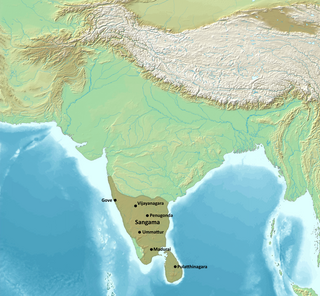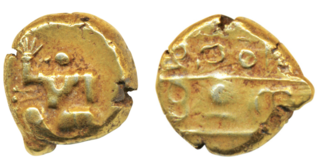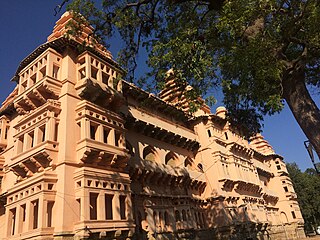Related Research Articles

The Vijayanagara Empire was a medieval Hindu empire that covered much of the region of Southern India, ruling the lands of the modern states of Karnataka, Andhra Pradesh, Tamil Nadu, Kerala, Goa, and some parts of Telangana and Maharashtra. It was established in 1336 by the brothers Harihara I and Bukka Raya I of the Sangama dynasty, members of a pastoralist cowherd community that claimed Yadava lineage. The empire rose to prominence as a culmination of attempts by the southern powers to ward off Turco-Persian Muslim invasions by the end of the 13th century. At its peak, it conquered almost all of Southern India's ruling dynasties and pushed the Turco-Persian sultans of the Deccan beyond the Tungabhadra-Krishna River doab region, in addition to annexing Gajapati Empire (Odisha) up to the Krishna River, thus becoming a notable power.

Krishnadevaraya was an emperor of the Vijayanagara Empire reigning from 1509 to 1529. He was the third monarch of the Tuluva dynasty, and is considered to be one of the greatest rulers in Indian history. He ruled the largest empire in India after the fall of the Islamic Delhi Sultanate. Presiding over the empire at its zenith, he is regarded as an icon by many Indians. Krishnadevaraya earned the titles Andhra Bhoja, Karnatakaratna Simhasanadeeshwara, Yavana Rajya Pratistapanacharya, Kannada Rajya Rama Ramana, Gaubrahmana Pratipalaka and Mooru Rayara Ganda. He became the dominant ruler of the peninsula by defeating the sultans of Bijapur, Golconda, the Bahmani Sultanate and the Gajapatis of Odisha, and was one of the most powerful Hindu rulers in India.

BukkaRaya I was an emperor of the Vijayanagara Empire from the Sangama Dynasty. He was a son of Bhavana Sangama, the chieftain of a cowherd pastoralist community, who claimed kuruba or Gadaria descent. The first Bahmani-Vijayanagar War was occurred during the reign of Bukka Raya I, in which he was besieged, and sued for peace.

Virupaksha Raya II (1465–1485) was an Emperor of Vijayanagara from the Sangama dynasty.
The Saluva dynasty was the second dynasty to rule the Vijayanagara Empire and was created by the Saluvas, who by historical tradition were natives of the Kalyani region of northern Karnataka in modern India. The Gorantla inscription traces their origins to this region from the time of the Western Chalukyas and Kalachuris of Karnataka. The term "Saluva" is known to lexicographers as "hawk" used in hunting. They later spread into the east coast of modern Andhra Pradesh, perhaps by migration or during the Vijayanagara conquests during the 14th century.
Tuluva is the name of the third Dynasty of the Vijayanagara Empire. The dynasty traces its patrilineal ancestry to Tuluva Narasa Nayaka, a powerful warlord from the westerly Tulu speaking region. His son Narasimha Nayaka arranged for the assassination of the weak Narasimha Raya II bringing an end to the rule of the Saluva dynasty. Narasimha Nayaka later assumed the Vijayangara throne as Viranarasimha Raya bringing the Tuluva dynasty to prominence. The dynasty was at its zenith during the rule of Krishnadevaraya, the second son of Tuluva Narasa Nayaka.

Vyāsatīrtha, also called Vyasaraja or Chandrikacharya, was a Hindu philosopher, scholar, polemicist, commentator and poet belonging to the Madhwacharya's Dvaita order of Vedanta. As the saint of the Vijayanagara Empire, Vyasatirtha was at the forefront of a golden age in Dvaita which saw new developments in dialectical thought, growth of the Haridasa literature under bards like Purandara Dasa and Kanaka Dasa and an increased spread of Dvaita across the subcontinent.
Saluva Narasimha Deva Raya was an emperor of the Vijayanagara Empire from the Saluva Dynasty. A patron of the Madhwa saint Sripadaraya, he authored the Sanskrit work Rama Bhyudayam. He also patronised Kannada poet Kavi Linga.

Sripadaraja or Sripadaraya, also known by his pontifical name Lakshminarayana Tirtha, was a Hindu Dvaita philosopher, scholar and composer and the pontiff of the Madhvacharya mutt at Mulbagal. He is widely considered the founder of Haridasa movement along with Narahari Tirtha. He has influenced both Carnatic music and Hindustani music through his compositions. His songs and hymns, written under the mudra of Ranga Vitthala, contain the distillation of Dvaita principles infused with mysticism and humanism. He is also credited with the invention of the suladi musical structure and composed 133 of them along with several kirtanas. He was the advisor of Saluva Narasimha Deva Raya and mentored the young Vyasatirtha. He also authored a commentary on Jayatirtha's Nyaya Sudha called Nyayasudhopanyasa-Vagvajra. Sripadaraja is believed to be the incarnation of Dhruva.
Pemmasani Nayaks were a ruling clan in the south Indian state of Andhra Pradesh. They came into prominence during Vijayanagara Empire. After the Battle of Talikota in 1565 AD, the collapse of Vijayanagara Empire led to the emergence of Pemmasani Nayakas in the Rayalaseema region. They belonged to the Kamma social group.

Vijayanagara literature was produced in the Vijayanagara Empire during a golden age of literature in South India in general. The rulers patronised Kannada, Telugu, Sanskrit and Tamil scholars who wrote in the Jain, Virashaiva and Vaishnava traditions. The period produced hundreds of works on all aspects of Indian culture, religion, biographies, prabhandas (stories), music, grammar, poetics and medicine. An attempt is made in this section to list the various poets and saints and their most famous works.
Tuluva Narasa Nayaka was an Indian general and later an Imperial Regent who founded the Tuluva dynasty of the Vijayanagara Empire. He was the father of the Emperors Viranarasimha Raya, Krishnadevaraya and Achyuta Deva Raya.
Vira Narasimha Raya became the Emperor of Vijayanagara after the death of his predecessor Narasimha Raya II. He was the older half-brother of Krishnadevaraya.
Narasimha Raya II ( Narasimha II, Immadi Narasimha Raya or Dhamma Thimma Raya) was the third and last emperor from the Saluva dynasty, the second of the four dynasties to rule the Vijayanagara Empire.
Sriranga Deva Raya was the second Emperor of Vijayanagara from the Aravidu Dynasty. He reigned the empire from the fortress of Penukonda. Sriranga succeeded his father, Emperor Tirumala Deva Raya. After the fall of Vijayanagara to Turko-Persian Sultanates of Deccan, he carried out the restoration of the empire from Penukonda. His reign was marred with repeated invasions and subsequent losses of territory to his Turko-Persian Muslim neighbours.
Events from the year 1505 in India.

Chandragiri Fort is an historical fort located in the Chandragiri suburb of Tirupati. It is situated in Tirupati district of Andhra Pradesh, India. It is mostly associated with the Vijayanagara Emperors. In 1460 CE Odra Gajapati Kapilendra Dev captured the Chandragiri Fort.
Chamarajara Wodeyar II was the fourth raja of the Kingdom of Mysore from 1478 until 1513.

Vira Pratapa Purushottama Deva was the second Gajapati emperor of Odisha who ruled from 1467 to 1497 C.E. He was the second ruler from the Suryavamsa Gajapati Empire. His father Gajapati Kapilendra Deva Routaraya chose him as his heir to rule the Gajapati Empire at the banks of river Krishna where he breathed his last. This decision infuriated his elder brother Hamvira Deva who was a battle hardened and successful warrior fulfilling the task of conquering the southern territories and expeditions against the Vijayanagara Empire as wished by his father.
References
- Suryanath U. Kamath, A Concise history of Karnataka from pre-historic times to the present, Jupiter books, MCC, Bangalore, 2001 (Reprinted 2002) OCLC: 7796041